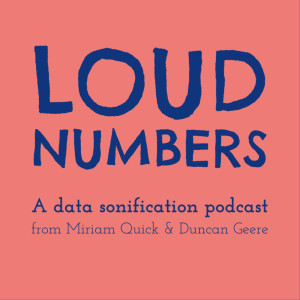
Every spring since 1916, the residents of Nenana, Alaska, have placed a tripod on the frozen Tanana river and placed bets on when the ice will melt, pulling it over. The measurement method has stayed the same over a century, making the competition records a valuable source of data for climatologists studying how the planet - and particularly the polar regions - are changing.
The Natural Lottery turns this climate data into a techno track. The higher the pitch of the chords in the track, the earlier the ice melted that year (using a 10-year moving average). These chords go up and down in pitch, but on the whole they get higher as the music progresses, showing the ice melting earlier and earlier as climate change in Nenana takes hold.
Two other data layers can be heard in the track. During the winter, the aurora borealis swirls through the skies of Alaska and its strength rises and falls in eleven-year sunspot cycles. These are sonified as an ethereal shimmer in the background, based on real data from the Royal Observatory of Belgium - the louder the sound, the more sunspots heard in a given month.
Then there’s CO2. In the background of the track, faint at first and louder and louder over time, you’ll hear a siren. The pitch of the siren represents carbon dioxide levels in the atmosphere, measured by the observatory at Mauna Loa in Hawaii.
They rise and fall each year as forests grow and die back in the northern hemisphere, which has more land. That’s why the pitch of the siren wobbles a little. But they also increase over time and rise to a worrying climax near the end of the track.
Finally, there are a whole lot of other musical elements that don’t represent any data. They’re just there to make the track sound good.
DataThe track covers the time period from January 1917 to December 2020 inclusive.
Annual tripod data comes from the Nenana Book of Guesses, with data for the last few years gathered from news reports and appended manually.
https://www.nenanaakiceclassic.com/2018%20Book_recovered.pdf
Monthly sunspot data comes from the Royal Observatory of Belgium.
http://www.sidc.be/silso/datafiles
Monthly CO2 data for 1917-2014 comes from the Institute for Atmospheric and Climate Science (IAC) at the Eidgenössische Technische Hochschule in Zürich, Switzerland.
https://www.co2.earth/historical-co2-datasets
Monthly CO2 data for 2015-2020 comes from the US National Oceanic and Atmospheric Administration (NOAA) https://gml.noaa.gov/webdata/ccgg/trends/co2/co2_mm_gl.txt
More Episodes
 2024-04-12
2024-04-12
 2024-04-11
2024-04-11
 2023-07-24
2023-07-24
 2021-08-02
2021-08-02
 2021-07-19
2021-07-19
 2021-07-05
2021-07-05
 2021-06-21
2021-06-21
 2021-04-10
2021-04-10
Create your
podcast in
minutes
- Full-featured podcast site
- Unlimited storage and bandwidth
- Comprehensive podcast stats
- Distribute to Apple Podcasts, Spotify, and more
- Make money with your podcast
It is Free
- Privacy Policy
- Cookie Policy
- Terms of Use
- Consent Preferences
- Copyright © 2015-2024 Podbean.com






